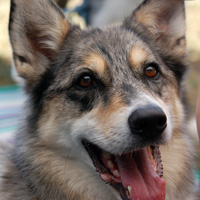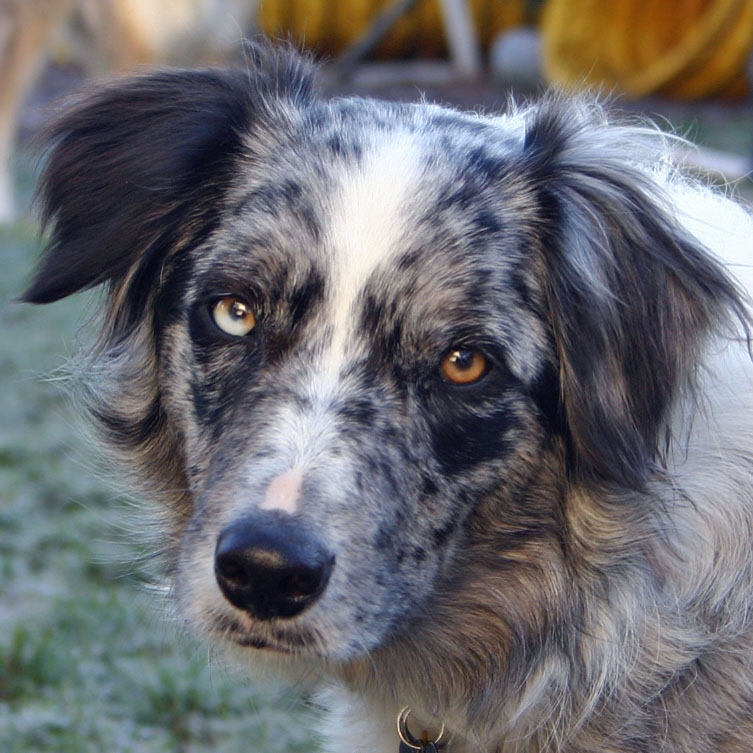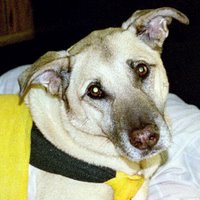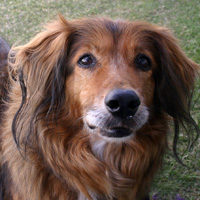Behind the Bay Team USDAA Southwest Regionals
SUMMARY: What classes we offer, why, and how
Just a note: I took no photos over the whole weekend, not one. Hard to believe. Never tried to hand off my camcorder to anyone to video any of our runs, either. Fortunately another Bay Teamer took some shots. Unfortunately, this is me and Tika leaving the Steeplechase ring after she came out of the tunnel limping, and me rubbing her down a bit afterward. Ah, well, it's photos anyway. Thanks, Sandra!
Bay Team's regionals seem to go very smoothly. In fact, so do most of our trials. Some of it comes from lots of experienced people jumping in to help. Some of it comes from having one miracle of a club member who makes everything happen from mostly behind the scenes. Some of it comes from our lock-step rotation groups.
The rotation groups work very much like they do at the USDAA Nationals, although I can no longer recall whether we did them first or the nationals did them first. For a small trial where all the classes can fit into one ring, or even two, it's not necessarily needed. But we've found that, with 3 rings or more at ANY trial, rotation groups make a huge improvement in how trials run. First, it reduces conflicts to almost nothing. Second, it makes it easier for people to work because they know exactly how the classes will change.
Here's what we do: Divide all the masters and tournament dogs into an appropriate number of rotation groups--3 for smaller trials, 4 for bigger trials and regionals. Assign everyone who's in the same family or on the same team to the same rotation group. Try to keep everyone who's in a small height class in the same group to reduce jump-height changes.
You might imagine that this is no small task. Our supreme show secretary has a program that pulls out all the chains of these relationships. It becomes an issue only when, say everyone at the trial is somehow related to everyone else at the trail--sort of a 100 degrees of separation thing. Then some manual tweaking has to occur. I can't imagine doing all of this manually, but I suppose it could be done.
We put one class into each of 3 or 4 rings, then rotate the groups through the rings. For example, on Saturday, the four DAM individual classes were in four different rings. First round, group A ran Team Gamblers in ring 1, group B ran Team Jumpers in ring 2, etc. We wait for ALL rings to finish the first rotation--this is key--then give a 5-minute break for whatever needs to be done to get the rings and workers ready for the next group. Groups rotate clockwise to the next ring, and everyone again starts at the same time; now Group A is in Ring 2 doing Team Jumpers, and so on.
Repeat until everyone has run all the classes.
To facilitate this, we have a microphone goddess who waits for all the rings' chief ring stewards to confirm that all of their workers & judges are ready to go.
It works best when there is one more group than there are rings--so, for example, on Sunday and Monday, we had 3 masters/tournament rings going, with the same 4 rotation groups, so one group was always off and in THEORY would be available to fill out our volunteer ring help positions. Usually this works well.
The other big part is that--just like at the nationals--everyone has to walk all the courses first thing in the morning. We do those in rotation, too--everyone gets something like 8 minutes to walk each course.
This works very well. USDAAers now seem to accept this, although there was some resistance when we first did it. CPEers--including judges--often have a hard time with this. They do not WANT to wait for the other groups to finish. And some competitors complain... "If this ring had run straight through, then *I* could have gone home 3 hours earlier." Yeah, right, means you're not sticking around to help in the other rings to help everyone else get home earlier. And you've got only one dog who's entered in only 3 classes--we should optimize our schedule for *you* rather than for the more typical competitor who's in all the classes and has a 40% chance of running 2 or more dogs?
But we are firm, and it works. Most people like it because they can relax. They know that they're not going to miss a walkthrough because everyone walks through at the same time.
When everyone has rotated through all the rings, then we rebuild for our second round of the day (if there is one), walk them, and run in the same way.
On Friday, we had one class: Pairs Relay. Fewer people entered that evening. We simply split the 22/26" championship masters dogs into one ring and the rest of hte masters/p3 dogs into a second ring.
On Saturday, the four DAM individual events ran first, then Grand Prix round 1 and Team Relay ran in the afternoon.
On Sunday, Masters Standard and Gamblers ran in 2 rings and Steeplechase Round 1 in the third; in the afternoon, we ran the Grand Prix Round 2. Original plan was to split it into 2 rings by rotation groups, but we had so few qualifiers that it all just ran in the same ring.
Similar on Monday: Masters Snooker, Standard, and Jumpers first in rotation, then Steeplechase Round 2 in one ring.
Worked like a charm.
We had one other ring for starters and advanced classes that did NOT go in rotation with the masters/tournament classes. If you had dogs in starters or advanced, you could indeed have conflicts, and we made it clear that that ring had precedence because there were so many fewer dogs. But if you weren't in St or Adv, you never had conflicts all weekend, never!
Very nice, much more relaxing than, say, a couple of my experiences before rotation groups: At USDAA Nationals in 2000 or 2001, where I had nothing for 5 hours, then ran my two dogs in 4 different rings virtually simultaneously (so lots of working out conflicts and trying to be there), then had nothing again for 2 hours. And again at one of our first four-ring trials, where I had a starters dog and masters dog and once again ended up in 4 rings almost simultaneously, with Masters Snooker where I couldn't move my position much and starters where the class was so small, etc. I exclaimed as I ran from ring to ring, "Four rings, no waiting!"
Our superuber secretary has also developed a database application through many years of experience that helps schedule all the classes, prints the reports, and so on, and for a few years now has also done all the calculations for Team and Steeplechase. Very helpful.
So: Regionals. How do we decide what events to offer? Have to offer the three Tournament events: Team (which is 5 classes), Steeplechase (2 rounds), and Grand Prix (2 rounds). We also want to offer enough of the regular classes to make it worth people's time to come. But not so many as to make the days brain-numbingly long. We've learned the hard way to not try to cram in too many classes.
And that's about it!
Labels: Bay Team, photos, trials, USDAA trial
Complete list of labels





4 Comments:
I think the CO Regional is using the group rotation system for the DAM team classes but you only ever walk 2 classes at a time. I think. It's a good system for managing so many people, I'm not sure how else you do it without making everyone crazy.
One of the main reasons I chose not to go to Regionals this year was that last year I ended up with maybe 3 minutes to walk the Finals course of the Grand Prix because it conflicted with the Masters/P3 Snooker walk-through and I cared more about that. The club and the Snooker judge came up with a way to avoid the conflict but the Grand Prix judge refused to cooperate and did his own thing and they were calling me to the line in Grand Prix as I was exiting the Snooker walk through. With the rotation system everyone is on the same page and hopefully it'll help things run more smoothly this year.
I don't like walking all my courses first thing in the morning and running some of them 6-7 hours later but I'm not sure how else you manage all those people at the big events and avoiding conflicts is by far the bigger issue.
I had to make sure to take a few minutes sometime before each run to stand and look at the course (and if possible watch some people run it) to review the course and my handling. Have discovered that it helps if I make some quick notes on the course maps right after each walk-through on where I want to cross or hold back or nonobvious things like that.
Interesting...the regional we had here last year was so small there weren't a lot of conflicts. I remember thinking, this isn't any big deal, it's just like being out our usual USDAA trial :)
We had 186 runs Friday night split across 3 rings, started running around 5:30 and were finished before dark.
1500 runs saturday divided among 5 rings, almost 1000 runs sunday among 4 rings, 850 Sunday among 4 rings (although the starters/adv ring had only 150, so well over 200 per ring in the masters/tourn rings).
So they were full days but not horrifically full. Finished at decent times in the afternoon all 3 days.
Post a Comment
Links to this post:
Create a Link
<< Home